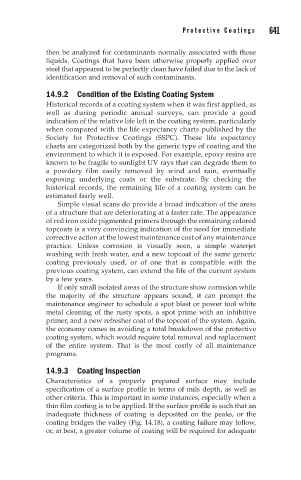Page 687 - Corrosion Engineering Principles and Practice
P. 687
640 C h a p t e r 1 4 P r o t e c t i v e C o a t i n g s 641
then be analyzed for contaminants normally associated with those
liquids. Coatings that have been otherwise properly applied over
steel that appeared to be perfectly clean have failed due to the lack of
identification and removal of such contaminants.
14.9.2 Condition of the Existing Coating System
Historical records of a coating system when it was first applied, as
well as during periodic annual surveys, can provide a good
indication of the relative life left in the coating system, particularly
when compared with the life expectancy charts published by the
Society for Protective Coatings (SSPC). These life expectancy
charts are categorized both by the generic type of coating and the
environment to which it is exposed. For example, epoxy resins are
known to be fragile to sunlight UV rays that can degrade them to
a powdery film easily removed by wind and rain, eventually
exposing underlying coats or the substrate. By checking the
historical records, the remaining life of a coating system can be
estimated fairly well.
Simple visual scans do provide a broad indication of the areas
of a structure that are deteriorating at a faster rate. The appearance
of red iron oxide pigmented primers through the remaining colored
topcoats is a very convincing indication of the need for immediate
corrective action at the lowest maintenance cost of any maintenance
practice. Unless corrosion is visually seen, a simple waterjet
washing with fresh water, and a new topcoat of the same generic
coating previously used, or of one that is compatible with the
previous coating system, can extend the life of the current system
by a few years.
If only small isolated areas of the structure show corrosion while
the majority of the structure appears sound, it can prompt the
maintenance engineer to schedule a spot blast or power tool white
metal cleaning of the rusty spots, a spot prime with an inhibitive
primer, and a new refresher coat of the topcoat of the system. Again,
the economy comes in avoiding a total breakdown of the protective
coating system, which would require total removal and replacement
of the entire system. That is the most costly of all maintenance
programs.
14.9.3 Coating Inspection
Characteristics of a properly prepared surface may include
specification of a surface profile in terms of mils depth, as well as
other criteria. This is important in some instances, especially when a
thin film coating is to be applied. If the surface profile is such that an
inadequate thickness of coating is deposited on the peaks, or the
coating bridges the valley (Fig. 14.18), a coating failure may follow,
or, at best, a greater volume of coating will be required for adequate

